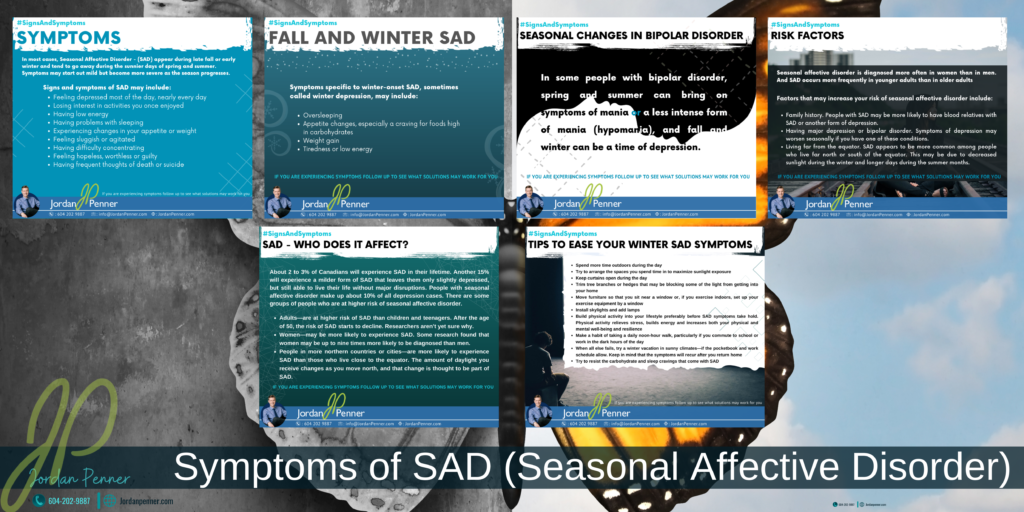
In most cases, Seasonal Affective Disorder – (SAD) appear during late fall or early winter and tent to go away during the sunnier days of spring and summer. Symptoms may start out mild but become more severe as the season progresses.
Signs and symptoms of SAD may include:
- Feeling depressed most of the day, nearly every day
- Losing interest in activities you once enjoyed
- Having low energy
- Having problems with sleeping
- Experiencing changes in your appetite or weight
- Feeling sluggish or agitated
- Having difficulty concentrating
- Feeling hopeless, worthless or guilty
- Having frequent thoughts of death or suicide
IF YOU ARE EXPRERIENCING SYMPTOMS FOLLOW UP TO SEE WHAT SOLUTIONS MAY WORK FOR YOU.
FALL AND WINTER SAD
Symptoms specific to winter-onset SAD, sometimes called winter depression, may include:
- Oversleeping
- Appetite changes, especially a craving for foods high in carbohydrates
- Weight gain
- Tiredness or low energy
IF YOU ARE EXPRERIENCING SYMPTOMS FOLLOW UP TO SEE WHAT SOLUTIONS MAY WORK FOR YOU.
SEASONAL CHANGES IN BIPOLAR DISORDER
In some people with bipolar disorder, spring and summer can bring on symptoms of mania or a less intense form of mania (hypomania), and fall and winter can be a time of depression.
IF YOU ARE EXPRERIENCING SYMPTOMS FOLLOW UP TO SEE WHAT SOLUTIONS MAY WORK FOR YOU.
RISK FACTORS
Seasonal affective disorder is diagnosed more often in women than in men. And SAD occurs more frequently in younger adults than in older adults
Factors that may increase your risk of seasonal affective disorder include:
- Family history. People with SAD may be more likely to have blood relatives with SAD or another form of depression.
- Having major depression or bipolar disorder. Symptoms of depression may worsen seasonally if you have one of these conditions.
- Living far from the equator. SAD appears to be more common among people who live far north or south of the equator. This may be due to decreased sunlight during the winter and longer days during the summer months.
IF YOU ARE EXPRERIENCING SYMPTOMS FOLLOW UP TO SEE WHAT SOLUTIONS MAY WORK FOR YOU
SAD – WHO DOES IT AFFECT?
About 2 to 3% of Canadians will experience SAD in their lifetime. Another 15% will experience a milder form of SAD that leaves them only slightly depressed, but still able to live their life without major disruptions. People with seasonal affective disorder make up about 10% of all depression cases. There are some groups of people who are at higher risk of seasonal affective disorder.
- Adults – are at higher risk of SAD than children and teenagers. After the age of 50, the risk of SAD starts to decline. Researchers aren’t yet sure why.
- Women – may be more likely to experience SAD. Some research found that women may be up to nine times more likely to be diagnosed than men.
- People in more northern countries or cities – are more likely to experience SAD than those who live close to the equator. The amount of daylight you receive changes as you move north, and that change is thought to be part of SAD.
IF YOU ARE EXPRERIENCING SYMPTOMS FOLLOW UP TO SEE WHAT SOLUTIONS MAY WORK FOR YOU.
TIPS TO EASE YOUR WINTER SAD SYMPTOMS
- Spend more time outdoors during the day
- Try to arrange the spaces you spend time in to maximize sunlight exposure
- Keep curtains open during the day
- Trim tree branches or hedges that may be blocking some of the light from getting into your home
- Move furniture so that you sit near window or, if you exercise indoors, set up your exercise equipment by window
- Install skylights and add lamps
- Build physical activity into your lifestyle preferably before SAD symptoms take hold. Physical activity relieves stress, builds energy and increases both your physical and mental well-being and resilience
- Make a habit of taking a daily noon-hour walk, particularly if you commute to school or work in the dark hours of the day
- When all else fails, try a winter vacation in sunny climates – if the pocketbook and work schedule allow. Keep in mind that the symptoms will recur after you return home
- Try to resist the carbohydrate and sleep craving that come with SAD
IF YOU ARE EXPRERIENCING SYMPTOMS FOLLOW UP TO SEE WHAT SOLUTIONS MAY WORK FOR YOU

